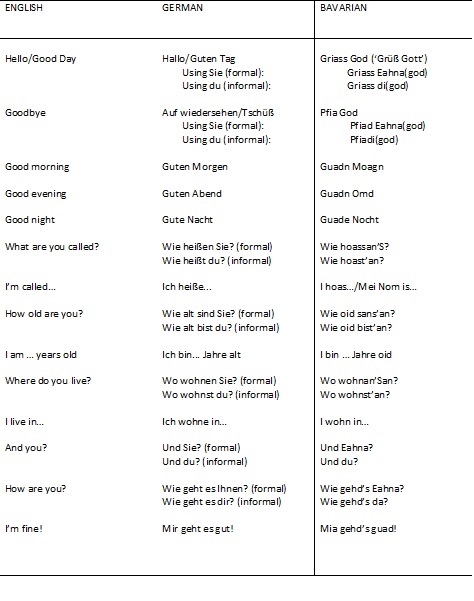A while back I said I wanted to introduce some Bavarian (Bairisch) to the blog. I wrote a couple of posts on the Bavarian language, which you can read by clicking on their titles below:
An Introduction to Bavarian
I Liab Di: Bavarian Love
Words and Signs you Might Encounter in Deepest Bavaria
However, I realise now that I got a little carried away and should’ve started with the basics, so that’s what this post is all about. This post is both intended for people who are complete beginners to German, and are interested in seeing the differences between Hochdeutsch (high or standard German) and one of Germany’s many dialects, and for more advanced German learners who are looking for a new challenge!

So without further ado, here is a list of basic phrases translated from English into German into Bavarian.
Please note that the dialect I know and use is Mittelbairisch (Middle Bavarian), which is spoken in München, along the Donau river, and in parts of Austria. The words and spellings I use here reflect that, and you may see things spelt or pronounced differently in other parts of Bavaria (see this map for a vague idea of what is spoken where).

This is a photo, so feel free to print/save it! By Constanze Arnold
As you can see, there are definite differences between Hochdeutsch (Standard German) and Mittelbairisch (Middle Bavarian). However, in many cases you can recognise the German word that the Bavarian comes from. Some examples are:
hoas is heiße (Ich heiße… – I am called…)
oid is alt (Ich bin … Jahre alt – I am … years old)
guad is gut (Mir geht es gut – I’m well/fine)
They are different, but they are recognisable.
To practise recognising these differences, here’s a little extract from the newspaper TZ, written in Bairisch. Can you recognise the Bairisch words, and tell me which German words they come from?
„Minga – Am Freidog erscheint de ganze tz auf Bairisch. Von vorn bis hintn! Rudi Bögel, da Chef von da Zeitung, mocht hia kloa, warums des Dialekt-Experiment übahabt gibt.
Am Freidog, liabe Leser, hams wos in der Hand, wos einmalig is! De ganze tz auf Bairisch. Vo vorn bis hint! Jetzt wern Sie sich frogn, warum mia des macha? Offizieller Anlass is da intenationale „Tag der Muttersprache“. Und do hamma uns denkt: Dann schreima am Freidog einfach in unserer Muattersprach, nämlich Bairisch.“
(original text here)
And finally, a challenge to finish! Using the table above, tell me a little about yourself in Bavarian!
Pfia God!
Constanze x







Comments:
Lilypad:
Gruessdi!
From my family’s area of origin (Stuttgart) I know a tiny bit of Schwaebisch. I also worked in Innsbruck for a summer and I’ll tell you this: they call their dialect “Tirolerisch”, NOT Suedbairisch as the map shows. That would make them crazy mad. 😉
Alles Gute,
Lilypad in Seattle, WA, USA
Constanze:
@Lilypad Hahhaha I can imagine that they do! Thanks for the comment!
Pfia di! x